| Area |
Indian Creek |
| Topic |
Tour: Indian Creek Legacy from Previous Logging 1995 Part 1 |
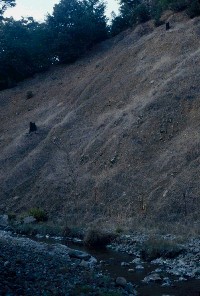 Click on image to enlarge (56K). Click here to display a larger version (153K).
Click on image to enlarge (56K). Click here to display a larger version (153K).This image shows inner gorge failure adjacent to Indian Creek. The stumps on the slope indicate that it was formerly forested and that logging likely contributed to the loss of slope stability. Decades after this slide occurred, there is still no prospect for recovery of conifers because of rocky soil conditions and the harsh summer sun on this south facing slope. Photo by Pat Higgins, October 1995.
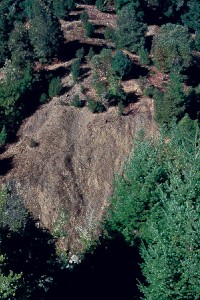 Click on image to enlarge (74K). Click here to display a larger version (194K).
Click on image to enlarge (74K). Click here to display a larger version (194K).This photo was taken looking down into the Indian Creek canyon with a landslide above the stream on the far side. Inner gorge failure was triggered by inordinately high flows and sediment yield in floods between 1955 and 1974.
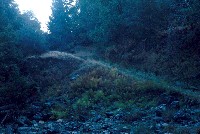 Click on image to enlarge (56K). Click here to display a larger version (211K).
Click on image to enlarge (56K). Click here to display a larger version (211K).Old failing logging road leading down to Indian Creek. Many old logging roads followed stream beds and failure adjacent to streams was a major source of sediment in past floods. Photo by Pat Higgins, October 1995.
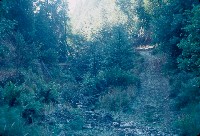 Click on image to enlarge (69K). Click here to display a larger version (190K).
Click on image to enlarge (69K). Click here to display a larger version (190K).This photo shows a road still in use which follows the tributary channel. An old road bed also appears at left in the photo with most of the fill having washed away. Photo by Pat Higgins, October 1995.
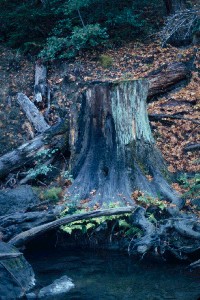 Click on image to enlarge (70K). Click here to display a larger version (174K).
Click on image to enlarge (70K). Click here to display a larger version (174K).Stream side logging has had a major detrimental effect on the health of Indian Creek by reducing large wood supply to the creek, changing the microclimate over the stream and decreasing root strength which kept stream banks from eroding. Photo by Pat Higgins, October 1995.
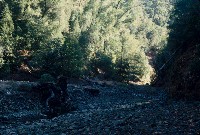 Click on image to enlarge (71K). Click here to display a larger version (189K).
Click on image to enlarge (71K). Click here to display a larger version (189K).This photo shows Indian Creek looking upstream above the North Fork. The intact rootwad and stump at left indicate the former stream width prior to debris torrenting. This stump was likely buried by past torrents but now exposed by a downcutting stream bed. The height of the terrace to the left of center behind the stump indicates the height of bedload transport in a major past storm event. Photo by Pat Higgins, October 1995.
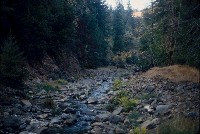 Click on image to enlarge (151K).
Click on image to enlarge (151K).This straight stream reach on Indian Creek is a long high gradient riffle. Streams suffering from cumulative watershed effects often have monotypic habitat like that above with a lack of pools. The terrace at right shows the height of bedload moved by the 1964 Flood or other large events. Photo by Pat Higgins, October 1995.
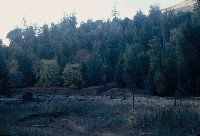 Click on image to enlarge (115K).
Click on image to enlarge (115K).The response reaches of Indian Creek, such as the one in this photo, would have been optimal salmonid habitat before logging and flood damage. Large wood and spawning sized substrates flushed from the transport and supply reaches of Indian Creek would have been deposited here. Unfortunately, these reaches are also affected for decades when aggraded because of their low gradient. Reaches like this, however, can be restored using bioengineering (see Anderson Creek Tour: Tebbutt Restoration Project). Photo by Pat Higgins, October 1995.
To learn more about this topic click Info Links
To view additional information (data source, aquisition date etc.) about this page, click Metadata
 Click on image to enlarge (56K). Click here to display a larger version (153K).
Click on image to enlarge (56K). Click here to display a larger version (153K). Click on image to enlarge (74K). Click here to display a larger version (194K).
Click on image to enlarge (74K). Click here to display a larger version (194K). Click on image to enlarge (56K). Click here to display a larger version (211K).
Click on image to enlarge (56K). Click here to display a larger version (211K). Click on image to enlarge (69K). Click here to display a larger version (190K).
Click on image to enlarge (69K). Click here to display a larger version (190K). Click on image to enlarge (70K). Click here to display a larger version (174K).
Click on image to enlarge (70K). Click here to display a larger version (174K). Click on image to enlarge (71K). Click here to display a larger version (189K).
Click on image to enlarge (71K). Click here to display a larger version (189K). Click on image to enlarge (151K).
Click on image to enlarge (151K). Click on image to enlarge (115K).
Click on image to enlarge (115K).